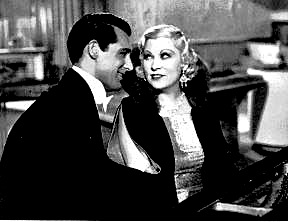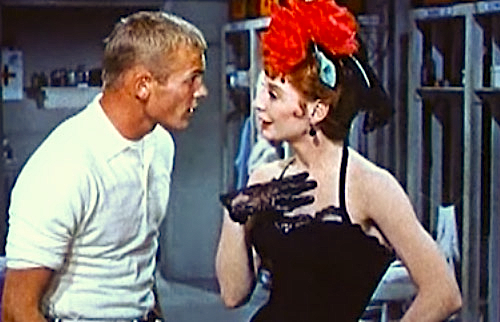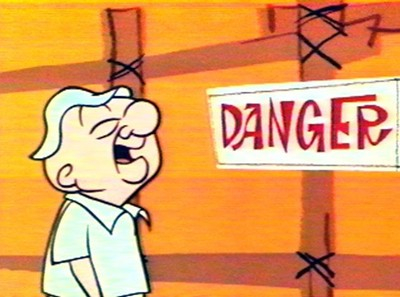
Remember back at the beginning of this series, when I introduced you to the world’s worst salesman, that genial soul who evinced continual exasperation because consumers insisted upon wandering into his flooring emporium and demanding, well, flooring? If only all of the benighted souls pursuing Marmoleum and carpet would leave him alone for a while, perhaps he could get some real work done — like, say, selling some flooring.
I may have met his match over the weekend: a delightful gentleman whom Home Depot had, perhaps unwisely, entrusted with the task of translating the customer’s choice of paint chip into a bucket of something that might conceivably resemble that hue if applied judiciously to a wall. “Oh, I couldn’t possibly match that,” he told me in a tone that implied I was a mad scientist, bent upon world domination through vicious color manipulation. “I’d have to special-order the base for something like that. Might take weeks.”
The color in question was, should you care to know it, royal blue. The wall behind him was painted approximately the same color as my proffered paint chip. I could, had I been so inclined, simply reached onto the shelf immediately behind his head and grabbed a can of spray paint in the shade I was requesting.
Besides, he had said something quite similar to the beige-loving lady in front of me in line. I waved paint chips from three different manufacturers under his nose, suggesting that if he did not have the base for my first choice in stock, he might conceivably be able to try one of the others.
He snorted derisively. “Yeah, but I’d have to go into the back for either of those.” He was visibly surprised when this piece of sterling logic did not instantly dissuade me from wanting to paint anything, ever. He pointed out that he would actually have to walk all the way to the back of the store in order to fulfill my madcap request, but I remained adamant. “Maybe you could come back tomorrow,” he suggested.
Eventually, I cajoled him into attempting to mix some royal blue for my trim, just to see if it was possible. If it turned out not to be, I assured him, I would follow his advice and paint the room in question flat white. But at least the question of whether royal blue was a color extant only in theory would have been resolved for the ages.
Mirabile dictu, it is in fact feasible for a well-equipped hardware store to produce a can of non-white paint. Feeling that the paint gods were on my side, I recklessly requested a couple of gallons of light blue paint for the rest of the room.
He sighed so gustily that customers in adjacent aisles wheeled around to see who had been punched in the gut. “Lady, if you want colors like that, you should go to a specialty store. Now, if you could pick something more reasonable…”
“Well, I could gold-leaf the room, but that might be a trifle hard on the eyes.”
He appeared pleased with the suggestion. “That would be beautiful. Of course, we don’t carry anything like that here.”
Clearly, the man was a minion of the wallpaper industry. By dint of persistent cross-examination, however, I did manage to elicit an admission that a light blue could in fact be produced by — I hope I’m not giving away an artist’s secret here — mixing a blue tint with white paint. Who knew?
Not wanting to press my luck, I apprehended my paint cans and fled. I was halfway through turning the third wall light blue before I was forced to resort to the second gallon. The paint within appeared to be a brilliant orange.
“Well, that happens,” my hero informed me when I returned. “Some of these tints are unstable.”
Why am I sharing this story of woe and disillusionment toward the end of Pitchingpalooza, you ask? Because like this paint-monger, many a conference pitcher seems to believe, wrongly, that communicating his resentment about having to pitch at all will not fundamentally color his hearer’s perception of whether he knows what he is talking about. Judging by the tone and speed of many conference pitches, quite a few pitchers’ primary goal is just to get the agent or editor listening to it to decamp as swiftly as possible.
But we know better, right? Pop quiz: what’s the actual purpose of a conference pitch?
Help yourself to a gold star out of petty cash if you instantly shouted, “Why, to convince the agent or editor to ask to see pages!” But if your first instinct was to say, “Um, to survive my pitch meeting without dying of fright?” we need to talk.
Conference pitching was not invented by sadists in order to torture innocent writers, you know — in theory, it’s intended to save aspiring writers some time. Instead of having to proceed through a tedious and often protracted querying process that does not always result in requests for pages, a writer can approach several agents at a conference, present her book’s premise convincingly, and walk out with one or more materials requests.
But that doesn’t mean that the people hearing your pitch won’t notice if you appear to be hurried, hostile, or just plain petrified; how you present yourself and your book does matter. It’s okay to acknowledge that you’re nervous; it’s not okay to act as though the agent or editor harbors a grudge against writers in general and you in particular, simply because she asks what category would most comfortably fit your book.
Resentment of the process shows up beautifully within the context of a tense pitching appointment, and for good reason. Just as a query that begins Since agents like you have set yourself up as the gatekeepers of the publishing industry, I guess I have to go through you to get published is much less likely to succeed than on that introduces one’s book politely, a pitch accompanied by a bitter denunciation of the business that keeps the hearer shod, fed, and with a roof over her head is substantially less likely to engender a request to see pages than one that doesn’t.
Go figure. Remember, it’s human nature to prefer to work with upbeat, friendly people, rather than angry, sullen ones. A good agent will expect to have a lot of contact with his clients; you’re going to want to come across as easy to work with on a long-term basis.
You don’t have to smile constantly, naturally, or heap the agent with compliments on her attire. (“A blue suit — well, I can certainly see that you live in the fashion capital of North America.”) Just be pleasant, will ya?
I sense some disgruntlement out there. Go ahead, get it out — far better that you air it here than in a pitch meeting. “But Anne,” the annoyed many cry, “that’s not fair! I want my book to be judged on its writing and my great premise, not how likable I am.”
Seriously? If the agent of your dreams asks to see the first 50 pages of your manuscript, you’re going to quibble about why?
But okay, if you insist: logically, it is impossible for an agent or editor to assess anyone’s writing based upon a verbal pitch alone. The pro can glean quite a bit of information about whether he is likely to be a good fit for a particular book project from a pitch — the book’s category, for instance, or its target audience, the inherent excitement of its central conflict, whether the intended reader will sympathize with the protagonist’s dilemma — but if the only way that you will accept representation is if the agent reads your first two sentences and falls in love with your voice, pitching is not going to produce the outcome you want. Sorry to be the one to break it to you.
If, however, you are the kind of writer who approaches conference pitching as a means of leap-frogging over the query stage and straight to submission, it’s in your best interest to be as pleasant as possible. It will get your great premise a more hospitable hearing.
Is everyone clear on that? If not, please speak up; that’s what the comments section is for, people.
Remember, too, that in addition to maintaining a positive attitude, striving for clarity, rather than mere accuracy of description, will help you win friends for your book. Aspiring writers very, very frequently forget this, but the author is not the only one who is going to have to pitch any given book. Your agent will be pitching it to editors; the editor that picks it up will be pitching it to an editorial committee.
Indeed, it’s scarcely an exaggeration to say that one of the main points of conference pitching is to render pitching a book someone else’s responsibility. Making it pellucidly clear what your book is about will go a long way toward convincing an agent that it would be worth her time to take a gander at your pages.
Obviously, clarity of presentation is especially challenging for writers of multiple-protagonist novels. Earlier in this series, I went over a few reasons that it’s a better idea to pitch the overall story of a multiple-perspective book, rather than try to replicate the various protagonists’ personal story arcs or talk about voice choices. It tends to be substantially less confusing for the hearer this way, but there’s another very good reason not to overload the pitch with too much in-depth discussion of how the story is told, rather than what the story is.
So please, I implore you, do not open your pitch with, “My novel is a multi-perspective first-person narrative, alternating between the point of view of a color-blind house painter, a tone-deaf piano teacher, and a pianist who has entirely lost the sense of touch.” It’s not that these characters are uninteresting; your hearer will want to hear the story.
Don’t make that face at me, multiple perspective-lovers. Presumably, you chose the multiple POV narrative style because it fits the story you want to tell, not the other way around, right? That’s the writer’s job, figuring out the most effective means of telling the tale. That doesn’t change the fact that in order for an agent to sell the book to an editor, or the editor to take the book to committee, he’s going to have to be able to summarize the story.
That’s right — precisely the task all of you would-be pitchers out there have been resenting for a month now. And inveterate queriers have been resenting for years.
If the story comes across as too complex to be able to boil down into terms that the agent or editor will be able to use to convince others that this book is great, your pitch may raise some red flags. It really does behoove you, then, not to include every twist and turn of the storyline — or every point of view. If you get stuck about how to tell the overarching story of a book with multiple protagonists (or multiple storylines, for that matter), you could conceivably pick one or two of the protagonists and present his/her/their story/ies as the book, purely for pitching purposes.
Ooh, that suggestion generated some righteous indignation, didn’t it? “But Anne,” I hear some of you upright souls cry, “isn’t that misleading?”
Not really. Remember, the point of the pitch is not to distill the essence of the book: it is to convince the agent or editor to ask to read it.
No one on the other side of the pitching table seriously expects to learn everything about a book in a 2-minute speech, any more than he would from a synopsis. If it were possible, how much of a storyline could there possibly be? Why, in fact, would it take a whole book to tell it?
“But Anne,” the upright whimper, “I don’t want to lie. Won’t I get in trouble for implying that my book has only two protagonists when it in fact has twelve?”
Trust me, this strategy is not going to come back and bite you later, at least not enough to fret over. What makes me so sure of that? Frankly, it would require the memory banks of IBM’s Big Blue for a pitch-hearer to recall everything he heard over the average conference period.
Blame it on pitch fatigue. After an agent or editor has heard a hundred pitches at a conference this weekend, and two hundred the weekend after that, he’s not going to say when he receives your submission, “Hey! This has 4 more characters than the author told me it did!”
I know, I know: we all want to believe that our pitches are the exception to this — naturally, the agent of our dreams will remember every adjective choice and intake of breath from OUR pitches, as opposed to everyone else’s. But that, my dears, is writerly ego talking, the same ego that tries to insist that we must get our requested submissions out the door practically the instant the agent or editor’s request for them has entered our ears.
In practice, it just isn’t so.
And shouldn’t be, actually, in a business that rewards writing talent. Given the choice, it’s much, much better for you if the agent of your dreams remembers that the writing in your submission was brilliant than the details of what you said in your 10-minute meeting.
As to the question of being misleading…well, I’ll get back to the desirability of telling the truth, the whole truth, and nothing but the truth a little later in this post. For now, let’s move on to the next reader’s question.
Insightful long-term reader Janet wrote in some time ago to ask how to handle the rather common dilemma of the writer whose local conference occurs whilst she’s in mid-revision: “What do you do when you realize that you might have to change the structure of the novel?” she asked. “Pitch the old way?”
I hear this question all the time during conference season, Janet. The answer really goes back to the pervasive writerly belief I touched upon briefly above, the notion that an agent or editor is going to remember any given pitch in enough detail down the road to catch discrepancies between the pitch and the book. But realistically, they’re going to be too tired to recall every detail by the time they get on the plane to return to New York, much less a month or two from now, when they get around to reading your submission.
Stop deflating, ego — this isn’t about you. It’s about them.
At a conference, the average agent or editor might be hearing as many as hundred pitches per day. Multiply that by the number of days of the conference — and multiply THAT by the number of conferences a particular agent or editor attends in a season, not to mention the queries and submissions she sees on a daily basis, and then you can begin to understand just how difficult it would be to retain them all.
I hate to bruise anyone’s feelings, but now that you’ve done the math, I ask you: how likely is it that she’s going to retain the specifics of, say, pitch #472?
You shouldn’t fret about that, because — pull out your hymnals, long-term readers — the purpose of a book pitch is to get the agent or editor to ask to read it, not to buy the book sight unseen. Since that request generally comes within a few minutes of the writer’s uttering the pitch, if it’s going to come at all, what you need to do is wow ‘em in the moment.
Although it is nice, admittedly, if yours is the pitch that causes an agent to scrawl in her notes, “Great imagery!”
That’s why, in case you’ve been wondering, I’ve been harping so much throughout Pitchingpalooza about the desirability of including memorable details in your pitch. You have the pitch-hearer’s attention for only a few moments, and 9 times out of 10, she’s going to be tired during those moments. A vividly-rendered sensual detail or surprising situation that she’s never heard before is your best bet to wake her up.
Under the circumstances, that’s not an insignificant achievement. Don’t lessen your triumph by insisting that she be able to reproduce your pitch from memory six weeks hence — or that you need to get those requested materials to her before she forgets who you are. Accept that she may not remember you by the time she gets on the plane to go home from the conference, and take the time to whip your manuscript into shape before submission.
The upside of short memory spans: you don’t really need to worry if your story changes between the time you pitch or query it and when you submit the manuscript pages. That’s par for the course. Writers rewrite and restructure their books all the time; it’s not considered particularly sinister.
That being said, your best bet in the case of a book in the throes of change is to tell the story that you feel is the most compelling. If you haven’t yet begun restructuring, it will probably be the old one, as it’s the one with which you are presumably most familiar, but if you can make a good yarn out of the changes you envision, it’s perfectly legitimate to pitch that instead.
It honestly is up to you. As long as the story is a grabber, that is.
While we’re on the subject, let’s talk about the ethics of not mentioning those aspects of the book one is afraid might negatively influence a pitch-hearer’s view of the manuscript. The most popular proposed omissions: the book’s length and whether it is actually finished on the day of the pitching appointment.
Let me take the second one first, as it’s easier to answer. There is a tacit expectation, occasionally seen in print in conference guides, that a writer will not market a novel until she has a complete draft in hand, because it would not be possible for an agent to market a partial first novel. In fact, most pitching and querying guides will tell you that you should NEVER pitch an unfinished work.
Except that it isn’t quite that simple. Agented writers pitch half-finished work to their agents all the time, for instance.
Does that mean that you should? Well, it depends. It would most definitely be frowned-upon to pitch a half-finished book that might take a year or two to polish off — unless, of course, the book in question is nonfiction, in which case you’d be marketing it as a book proposal, not as an entire manuscript, anyway.
Let me repeat that, because it’s important: nonfiction books are typically sold on proposals, not the entire manuscript. Yes, even if it’s a memoir; although some agents do prefer to see a full draft from a previously unpublished writer, the vast majority of memoirs are still sold in proposal form.
So I ask you: could you realistically have your novel in apple-pie order within the next six months?
If so, that’s not an unheard-of lapse before submitting requested materials. And if you have a chapter of your memoir in terrific shape, could you pull a book proposal together within that timeframe? (For some guidance on what that might entail, please see the aptly-named HOW TO WRITE A BOOK PROPOSAL category on the archive list at the bottom right-hand side of this page.)
If the answers to all of those questions are a resounding “No, by gum!” you should consider holding off. Unless, of course, you’d just like to get in some pitching practice while the stakes are still low. But if you are pitching a novel just to get the hang of it (a marvelous idea, by the way), don’t make the mistake of saying that the manuscript isn’t done yet.
It’s considered rude. You’re supposed to have a fiction project completed before you pitch or query it, you know.
Confused? You’re not alone. Like so many of the orders barked at conference attendees, the expectation of market-readiness has mutated a bit in translation and over time. Take, for instance, the prevailing wisdom that maintains you should have a full draft before you pitch because an agent or editor who is interested will ask you for the entire thing on the spot.
As in they will fly into an insensate fury if you’re not carrying it with you at the pitch meeting.
But as I have mentioned earlier in this series, demanding to see a full or even partial manuscript on the spot doesn’t happen all that often anymore (and the insensate fury part never happened in the first place). 99.9% of the time, even an agent who is extremely excited about a project will prefer that you mail it — or e-mail it.
Seriously, she’s not in that great a hurry — and trust me, she’s not going to clear his schedule in anticipation of receiving your submission. I’ll bring this up again when I go over how to prep a submission packet (probably in September; I want to go over query basics first, so PLEASE, if you have pitched within the last few weeks and are impatient to send things off, read through the HOW TO PUT TOGETHER A SUBMISSION PACKET category before you drop anything in the mail) but I always advise my clients and students not to overnight anything to an agency or publishing house unless the receiving party is paying the postage.
Yes, even if an agent or editor asks you to overnight it.
I heard that horrified gasp out there, but the fact is, it’s a myth that overnighted manuscripts get read faster — yes, even if the agent asked you to send it instantly. That request is extremely rare, however; most submitters simply assume that they should get it there right away — or that their work will be seem more professional if it shows up in an overnight package.
That might have been true 20 years ago, when overnighting a manuscript would have been a rarity but here’s a news flash: FedEx and other overnight packaging is just too common to attract any special notice in a crowded mailroom these days.
If you’re worried about speed, Priority Mail (which gets from one location to another within the US in 2-3 days) is far cheaper — and if you write REQUESTED MATERIALS in great big letters on the outside of the package, might actually get opened sooner than that spiffy-looking overnight mail packet.
Besides, even if you did go to the trouble and expense to get your manuscript onto the requester’s desk within hours of the request, it can often be months before an agent reads a manuscript, as those of you who have submitted before already know.
Which means, in practical terms, that you need not send it right away. And that, potentially, means that a savvy writer could buy a little time that could conceivably be used for revision. Or even writing.
Catching my drift here? After all, if you’re going to mail it anyway…and the agent is going to be on vacation until after Labor Day…and if you could really get away with sending requested materials anytime between now and Christmas…and if the agent has asked for only the first three chapters…
Or, to put it in querying terms: if the agencies are going to take a month to respond to the letter…and then ask for the first 50 pages…and that has to get by a couple of screeners before they can possibly ask for the rest?
Starting to get the picture?
There’s no reason not to work those predictable delays into your pitching and querying timeline. Naturally, I would never advise anyone to pitch a book that isn’t essentially done, but let’s face it, it may well be months before the person sitting across the table from you in a pitch meeting asks to see the entire manuscript.
And you know what? You’re under no obligation to send it out instantly, even then. If you can get requested materials out the door within a few months, you should be fine.
Although I would not encourage any of you to join the 40% of writers who are asked to submit requested materials but never do, anyone who has ever written a novel can tell you that where writing is concerned, there is finished — as in when you’ve made it all the way through the story and typed the words THE END on the last page — and then there is done — as in when you stop tinkering with it.
Then there’s REALLY done, the point at which you have revised it so often that you have calculated the exact trajectory of the pen you will need to lob toward Manhattan to knock your agent or editor in the head hard enough to get him to stop asking for additional changes.
And then there’s REALLY, REALLY done, when your editor has changed your title for the last time and has stopped lobbying for you to transform the liberal librarian sister into a neo-conservative professional squash player who wrote speeches for Ronald Reagan in his spare time.
But frankly, from the point of view of the industry, no manuscript is truly finished until it is sitting on a shelf in Barnes & Noble. Until the cover is actually attached to the book, it is an inherently malleable thing.
The fact that everyone concerned is aware of this, I think, renders a bit of sophistry on the writer’s part over the question of whether a manuscript is completed somewhat pardonable.
This does NOT mean, however, that it is in your best interests to waltz into a pitch meeting and announce that the book isn’t finished yet — in a word, don’t. Because agents and editors are, as a group, perfectly aware that writers are prone to levels of tinkering that would make Dante’s inferno appear uncomplex, it’s actually not a question that gets asked much.
If you are asked? Sophistry, my dears, sophistry, of the type that agented and published writers employ all the time: “I’m not quite happy with it yet, but I’m very close.”
You are close to finishing it, aren’t you? And you aren’t completely happy about every syllable of the current text, right?
The question of whether to mention manuscript length is a bit more tortured, as it tends to generate a stronger knee-jerk response in pitches and query letters than the question of submission timing. Or so I surmise, from the response to the inevitable moment at every writers’ conference I have ever attended when some stalwart soul stands up and asks how long a book is too long.
Without fail, half the room gasps at the response.
I hesitate to give limits, for fear of triggering precisely the type of literalist angst I deplored a couple of days ago, but here are a few ballpark estimates. Currently, first novels tend to run in the 65,000 – 100,000 word range — or, to put it another way, roughly 250 – 400 pages. (That’s estimated word count, by the way, 250 x # of pages in Times New Roman, standard format. For the hows and whys of estimation vs. actual word count, please see the WORD COUNT category at right.) Standards do vary a bit by genre, though — check the recent offerings in your area to get a general sense.
If your book runs much over 400 pages, be prepared for some unconscious flinching when you mention the length. Or just don’t mention the length in your pitch; it’s not a required element.
And remember, these are general guidelines, not absolute prohibitions. Few agency screeners will toss out a book if it contains a page 401. Do be aware, though, that after a book inches over the 125,000 word mark (500 pages, more or less), it does become substantially more expensive to bind and print. (For more on this point, please see the rather extensive exchange in the comment section of a past post.)
If at all possible, then, you will want to stay under that benchmark. If you have not, don’t mention the length in your pitch or query.
Not just for marketing reasons, or at any rate not merely to preclude the possibility of an instinctive response to a book’s length. If a manuscript is too long (or too short, but that is rarer since the advent of the computer), folks in the industry often have the same response as they do to a manuscript that’s not in standard format: they assume that the writer isn’t familiar with the prevailing norms.
And that, unfortunately, usually translates into the submission’s being taken less seriously — and often, the pitch or query as well.
If your book is over or under the expected estimated length for your genre, you will probably be happier if you do not volunteer length information in either your pitch or your query. This is not dishonest — neither a pitcher nor a querier is under any actual obligation to state the length of the manuscript up front.
I’m not recommending that you actually lie in response to a direct question, of course — but if the question is not asked, it will not behoove you to offer the information. Remember, part of the art of the pitch involves knowing when to shut your trap. You will not, after all, be hooked up to a lie detector throughout the course of your pitch.
Although that would be an interesting intimidation strategy, one I have not yet seen tried on the conference circuit. Given the current level of distrust aimed at memoirists these days, I wouldn’t be at all surprised to see it come into fashion.
Yes, I know: many experts will tell you that you MUST include word count in your query, but as far as I know, no major agency has a policy requiring Millicent to reject queries where it’s not mentioned. Some agents will say they like to see it, for the simple reason that it makes it easier to weed out the longest and the shortest manuscripts — but if your book would fall into either of those categories, is it really in your interest to promote a knee-jerk rejection?
I’ll answer that one for you: no, it isn’t. For any reason.
Keep up the good work!


 (1) As with the keynote and the elevator speech, most pitchers make the mistake of trying to turn the pitch proper into a summary of the book’s plot, rather than a teaser for its premise.
(1) As with the keynote and the elevator speech, most pitchers make the mistake of trying to turn the pitch proper into a summary of the book’s plot, rather than a teaser for its premise. (2) Most pitchers don’t stop talking when their pitches are done.
(2) Most pitchers don’t stop talking when their pitches are done. (3) The vast majority of conference pitchers neither prepare adequately nor practice enough.
(3) The vast majority of conference pitchers neither prepare adequately nor practice enough. (4) Most pitchers harbor an absurd prejudice in favor of memorizing their pitches, and thus do not bring a written copy with them into the pitch meeting.
(4) Most pitchers harbor an absurd prejudice in favor of memorizing their pitches, and thus do not bring a written copy with them into the pitch meeting. (5) Most pitchers don’t realize until they are actually in the meeting that part of what they are demonstrating in the 2-minute pitch is their acumen as storytellers. If, indeed, they realize it at all.
(5) Most pitchers don’t realize until they are actually in the meeting that part of what they are demonstrating in the 2-minute pitch is their acumen as storytellers. If, indeed, they realize it at all. (6) Few pitches capture the voice of the manuscript they ostensibly represent. Instead, they tend to sound generic or vague.
(6) Few pitches capture the voice of the manuscript they ostensibly represent. Instead, they tend to sound generic or vague.
 (8) Very few pitches include intriguing, one-of-a-kind details that set the book being pitched apart from all others.
(8) Very few pitches include intriguing, one-of-a-kind details that set the book being pitched apart from all others. (9) Most pitchers assume that a pitch-hearer will hear — and digest — every word they say, yet the combination of pitch fatigue and hectic pitch environments virtually guarantee that will not be the case.
(9) Most pitchers assume that a pitch-hearer will hear — and digest — every word they say, yet the combination of pitch fatigue and hectic pitch environments virtually guarantee that will not be the case. (10) Few pitchers are comfortable enough with their pitches not feel thrown off course by follow-up questions.
(10) Few pitchers are comfortable enough with their pitches not feel thrown off course by follow-up questions. (11) Far too many pitchers labor under the false impression that if an agent or editor likes a pitch, s/he will snap up the book on the spot. In reality, the agent or editor is going to want to read the manuscript first.
(11) Far too many pitchers labor under the false impression that if an agent or editor likes a pitch, s/he will snap up the book on the spot. In reality, the agent or editor is going to want to read the manuscript first. If the agent is interested by your pitch, she will hand you her business card and ask you to send some portion of the manuscript — usually, the first chapter, the first 50 pages, or for nonfiction, the book proposal. If she’s very, very enthused, she may ask you to mail the whole thing.
If the agent is interested by your pitch, she will hand you her business card and ask you to send some portion of the manuscript — usually, the first chapter, the first 50 pages, or for nonfiction, the book proposal. If she’s very, very enthused, she may ask you to mail the whole thing.








